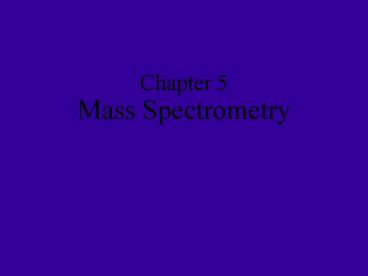UVVIS Spectroscopy - PowerPoint PPT Presentation
1 / 29
Title:
UVVIS Spectroscopy
Description:
retro Diels-Alder. McLafferty rearrangement. Alkane Fragmentation ... retro Diels-Alder cleavage. Alkyne Fragmentation. Molecular ion readily visible ... – PowerPoint PPT presentation
Number of Views:202
Avg rating:3.0/5.0
Title: UVVIS Spectroscopy
1
Chapter 5Mass Spectrometry
2
Mass Spectrometry Basics
- What information can be determined?
- Molecular weight
- Molecular formula (HRMS)
- Structure (from fragmentation fingerprint)
- Isotopic incorporation / distribution
- Protein sequence (MS-MS)
3
Mass Spectrometry Basics
- Mass spectrometry has 4 basic operations
- Sample introduction (analyte must be in vapor
phase) - Ionization
- Mass analysis ( separating ions by mass/charge
ratio) - Detection and quantitation
4
Sample Introduction
- Method Applications
- Batch (reservoir) gases, volatile liquids
- Direct insertion probe very low vapor
pressure solids and liquids - Membrane aqueous solutions, air samples
- Chromatography eluent LC-MS, GC-MS, etc.
5
Ionization Methods
- 1. Electron Ionization (EI)
- most common ionization technique, limited to
relatively low MW compounds (lt600 amu) - 2. Chemical Ionization (CI)
- ionization with very little fragmentation, still
for low MW compounds (lt800 amu) - 3. Desorption Ionization (DI)
- for higher MW or very labile compounds
- 4. Spray ionization (SI)
- for LC-MS, biomolecules, etc.
6
Electron Ionization (EI)
- vaporized sample is bombarded with high energy
electrons (typically 70 eV) - hard ionization method leads to significant
fragmentation - ionization is efficient but non-selective
- PLK Chapter 8 is written from an EIMS perspective
7
Electron Ionization
- Advantages
- inexpensive, versatile and reproducible
- fragmentation gives structural information
- large databases if EI spectra exist and are
searchable - Disadvantages
- fragmentation at expense of molecular ion
- sample must be relatively volatile
8
Chemical Ionization (CI)
- Vaporized sample reacts with pre-ionized reagent
gas via proton transfer, charge exchange,
electron capture, adduct formation, etc. - common CI reagents
- methane, ammonia, isobutane, hydrogen, methanol
- soft ionization gives little fragmentation
- selective ionization--only exothermic or
thermoneutral ion-molecule reactions will occur - choice of reagent allows tuning of ionization
9
Desorption Ionization (DI)
- Allows analysis of non-volatile or thermally
labile materials - Sample hit with large amount of energy in short
time - Secondary ion mass spectrometry (SIMS)
- Fast atom bombardment (FAB)
- Plasma desorption (PD)
- Laser desorption (LD)
- Matrix-assisted laser desorption (MALDI)
10
SIMS and FAB
- Sample in solid or liquid matrix in bombarded
with a stream of high energy ions (SIMS) or
neutral atoms (FAB) - The matrix absorbs most of the energy and has a
dramatic effect on ionization - Matrix contributes large amount of background
ions - Common matrices
- glycerol, dithiothreitol, diethanolamine,
m-nitrobenzyl alcohol - Additives can dictate ions formed
11
MALDI
- Sample/matrix hit by short laser pulse
- Matrix usually organic acid with strong
electronic absorption at lasers wavelength - Efficiently produces intact molecular ions (
usually MH and MNa ) - Useful for large biomolecules (up to 100,000 MW)
- Requires only pico- or femtomoles of material
- Matrix chosen for specific applications
12
Spray Ionization (SI)
- Sample solution shot through capillary to create
microdroplets, and ultimately intact molecular
ions - Good for high MW, thermally labile compounds
- Thermospray (TS)
- first spray method developed, no longer very
common - solution of sample sprayed through hot nozzle,
creating charged mini-droplets - Electrospray (ES)
- solution sprayed through nozzle with 2-5 kV
potential
13
Mass Analysis
- Five main methods of separating ions based on
mass/charge ratio - Magnetic sector analyzer
- Time of Flight (TOF) analyzer
- Quadrupole analyzer
- Ion trap (Varian Saturn MS)
- Ion cyclotron resonance
14
Fragmentation
- Governed by product ion stability
- consideration
- octet rule
- resonance delocalization
- polarizability and hyperconjugation
- electronegativity
- Stevensons Rule
- For simple bond cleavage, the fragment with
lowest ionization potential takes the charge - (in other words, the most stable ion is formed)
15
General Fragmentation Pathways
- One-bond cleavages (a-cleavages)
- Two-bond cleavages
- eliminate H-X
- retro Diels-Alder
- McLafferty rearrangement
16
Alkane Fragmentation
- Long chains give homologous series of m/z 14
units - Long chains rarely lose methyl radical
- Straight chain alkanes give primary carbocation
- branched alkanes have small or absent M
- enhanced fragmentation at branch points
- Cycloalkanes
- loss of side chain
- loss of ethylene fragments
17
Alkene Fragmentation
- Fairly prominent M
- fragment ions of CnH2n and CnH2n-1
- terminal alkenes lose allyl cation if possible
- Cycloalkenes
- prominent molecular ion
- retro Diels-Alder cleavage
18
Alkyne Fragmentation
- Molecular ion readily visible
- terminal alkynes readily lose hydrogen atom
- terminal alkynes lose propargyl cation if
possible
19
Aromatic Hydrocarbon Fragmentation
- Molecular ion usually strong
- alkylbenzenes cleave at benzylic carbon
- tropylium ion formation
- McLafferty rearrangement of aromatics
- need g-hydrogens
20
Alcohol Fragmentation
- Molecular ion strength depends on substitution
- primary alcohol weak M
- secondary alcohol VERY weak M
- tertiary alcohol M usually absent
- Dehydration fragmentation
- thermal vs. 1,4-dehydration of M
- Loss of alkyl group
- largest R group lost as radical
21
Ether Fragmentation
- Alpha-cleavage
- C-O cleavage
- requires stable cation to lose
- ion rearrangement
22
Carbonyl Compounds
- Dominant fragmentation pathways
- a-cleavage
- b-cleavage
- McLafferty rearrangement
23
Halide Fragmentation
- Loss of halogen atom
- Elimination of HX
- alpha-cleavage
- 1,4-rearrangement
24
MS analysis examples
25
C5H12O MW 88.15
26
C7H12Br MW 171.04
27
C9H10O MW 134.18
28
C11H12O 3 MW 192.21
29
C5H8O2 MW 100.12































